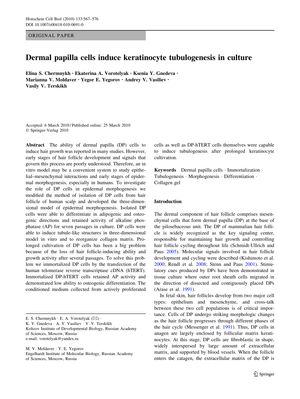TLDR Skin cells can help create early hair-like structures in lab cultures.
The study explored the role of human dermal papilla (DP) cells in epidermal morphogenesis, particularly their ability to induce tubule-like structures in keratinocyte cultures, which may mimic early hair follicle development. Researchers developed a new method for isolating DP cells and found that these cells could differentiate into adipogenic and osteogenic lineages and retain alkaline phosphatase activity for several passages. However, DP cells typically lose their hair-inducing ability after multiple passages. To overcome this, DP cells were immortalized with human telomerase reverse transcriptase cDNA (hTERT), which allowed extended cultivation but resulted in reduced differentiation potential. The study demonstrated that both wild-type and immortalized DP cells could induce keratinocyte tubulogenesis, suggesting their significant role in hair follicle development and potential use in studying dermal-epidermal interactions. The number of subjects or the size of the study population was not specified in the summary.
7 citations
,
February 2009 in “Cell and tissue biology”  120 citations
,
August 2008 in “The journal of investigative dermatology/Journal of investigative dermatology”
120 citations
,
August 2008 in “The journal of investigative dermatology/Journal of investigative dermatology” Cytokeratin 19 and cytokeratin 15 are key markers for monitoring the quality and self-renewing potential of engineered skin.
 479 citations
,
January 2005 in “BioEssays”
479 citations
,
January 2005 in “BioEssays” Hair follicle development is controlled by interactions between skin tissues and specific molecular signals.
268 citations
,
December 2003 in “Experimental Dermatology” Hair follicle cells can become fat and bone cells.
 208 citations
,
December 2003 in “Journal of Investigative Dermatology”
208 citations
,
December 2003 in “Journal of Investigative Dermatology” Certain cells from hair follicles can create new hair and contribute to hair growth when implanted in mice.
27 citations
,
December 1997 in “Archives of Dermatological Research” Rat dermal papilla cells have unique properties and interact differently with their environment compared to other skin cells.
 8 citations
,
September 1993 in “British journal of dermatology/British journal of dermatology, Supplement”
8 citations
,
September 1993 in “British journal of dermatology/British journal of dermatology, Supplement” A new method helps isolate key hair components to study hair growth and loss.
45 citations
,
May 1992 in “Journal of Investigative Dermatology” 7 citations
,
December 1991 in “Annals of the New York Academy of Sciences” Dermal papillae are crucial for hair growth and maintenance.
85 citations
,
January 1991 in “Journal of Investigative Dermatology”
 35 citations
,
January 2020 in “Skin Pharmacology and Physiology”
35 citations
,
January 2020 in “Skin Pharmacology and Physiology” The review concluded that keeping the hair-growing ability of human dermal papilla cells is key for hair development and growth.
 256 citations
,
October 2013 in “Proceedings of the National Academy of Sciences of the United States of America”
256 citations
,
October 2013 in “Proceedings of the National Academy of Sciences of the United States of America” Growing human skin cells in a 3D environment can stimulate new hair growth.
June 2010 in “Journal of Medicine and Life Science” Orostachys iwarenge Hara extract may help promote hair growth.
6 citations
,
January 1994 in “Skin Pharmacology and Physiology” Dermal papillae are crucial for hair growth and follicle development.
36 citations
,
November 1990 in “The Journal of Dermatology” Dermal papillae enhance hair follicle growth and structure.







